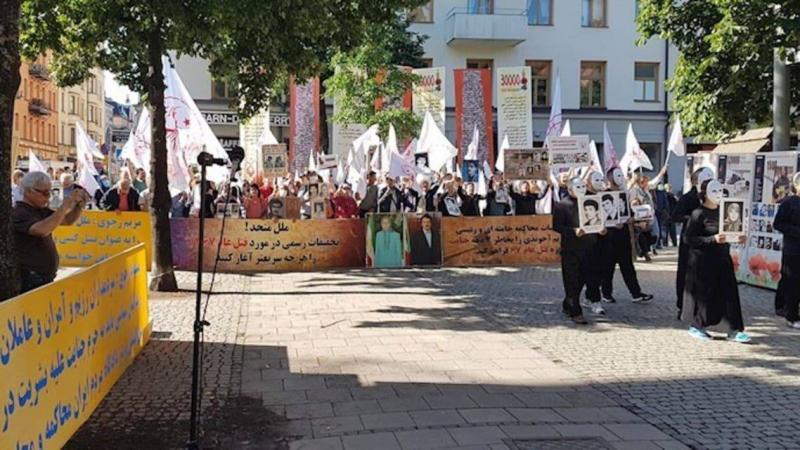The Swedish court specialized in international crimes began its second week of trial against Hamid Nouri, a former official in Iranian prisons, in Stockholm on Tuesday morning. He is charged with "crimes against humanity" for his role in the execution of approximately 4,000 political prisoners in Iran during the 1980s. The court has accused Nouri, who was arrested under global jurisdiction, of "war crimes," "mass murder," and "violating international law," according to the charge sheet presented by Swedish prosecutor Kristina Lindhuf Larson.
The court commenced by reading excerpts from a book by Ayatollah Hossein Ali Montazeri (Khomeini's deputy) regarding the massacre of executions in the 1980s. Montazeri wrote that visits to prisons were halted, around 3,800 prisoners were executed, and he requested a meeting with the committee that executed the sentences, known as the "Death Commission," which included current Iranian President Ebrahim Raisi (then deputy prosecutor), Morteza Eshraghi, Hossein Ali Neri, and Mostafa Pour Mohammadi. The Swedish prosecutor stated that these executions were carried out in rapid and sham trials that violated even Iranian law, in addition to breaching international laws. She read letters from Montazeri to Khomeini in which he protested the executions, followed by Montazeri's comments to the members of the Death Commission (Raisi, Neri, Eshraghi, and Pour Mohammadi), warning that "these executions harm us all and the revolution, making the victims martyrs… The world will judge us as criminals… the authority of Imam (Khomeini) and the guardianship of the jurist will be tarnished."
The prosecutor relied on the testimony of Geoffrey Robinson, a judge at the International Criminal Court, who was a member of the "Iran Tribunal." Robinson noted that prison heads, prosecutors, and their assistants, such as Hamid Nouri, took all necessary measures before the Death Commission's arrival, reviewed inmates' files, questioned them, and decided who would appear before the Death Commission. The prosecutor mentioned that the first wave of executions began from late July to mid-August 1988, targeting members and supporters of the Mujahideen Khalq, while the second wave occurred from August 27 to September 4, 1988, extending to leftist prisoners from various organizations.
Documenting the Massacre
Al-Arabiya.net conducted a series of interviews with witnesses, prosecutors, and families of victims against Nouri. Reza Shamirani, who spent ten years in prison and is one of the plaintiffs in the case, stated that he documented the 1988 execution of political prisoners in his 300-page book "An Arjemandha (Those Dearest)," which was accepted as evidence by the court. Shamirani recollected that on July 30, 1988, he was taken by Hamid Nouri to appear before the Death Commission and saw its members: Tehran's prosecutor Morteza Eshraghi, the legal governor Hossein Ali Neri, and deputy prosecutor Ebrahim Raisi. He confirmed that 135 inmates in his cell were executed within the first few days.
He added that individuals like Mohammad Ghaiseh, known as Nasrayan, and Hamid Nouri, along with Daoud Lashkari, executed the sentences in the Hosseiniyeh of Gohardasht Prison while Neri and Raisi roamed between Evin Prison in Tehran and Gohardasht in Karaj to issue death sentences against Mujahideen Khalq members.
Execution of Female Prisoners
Shamirani disclosed that during his transfer to court, he managed to lift the blindfold from his eyes and saw a group of female prisoners affiliated with the Mujahideen Khalq, including Monireh Rajavi, sister of Massoud Rajavi (the organization's leader), who was sentenced to four years in prison but was executed with her peers. He stated, "The execution was also carried out against MARYAM Kalazadeh Ghafouri and many of these sisters, whose names we have on a list, and we demand that the Swedish justice hold accountable those who committed these crimes."
Naserollah Marandi, a former political prisoner and a primary plaintiff in the court, told Al-Arabiya.net that he was imprisoned from 1980 to 1991 in Evin, Qezel Hesar, and Gohardasht Prisons for belonging to the Mujahideen Khalq, and he repeatedly witnessed how Nouri led the condemned to the gallows. He added, "I first met Hamid Nouri in 1986; he was known as Hamid Abbasi. He would take us for torture and wouldn’t allow us to exercise. He was the second in command after Nasrayan, the prison prosecutor, and I testified against him before the Swedish prosecutor."
Marandi mentioned that "Hamid Nouri, in his role as deputy prosecutor, along with Daoud Lashkari, the prison's security chief, would lead prisoners to the 'Death Corridor' on the first floor of Gohardasht Prison before they appeared before the Death Commission, deceiving prisoners by saying this was an Amnesty Committee."
Role of Ebrahim Raisi
Regarding the role of new Iranian President Ebrahim Raisi, Marandi stated, "On the day the executions began, I appeared before him dressed in civilian clothes as he served as deputy prosecutor, but he played a key role in the Death Commission appointed by Khomeini in issuing death sentences."
Hosein Farsi, who was imprisoned for 12 years and gave virtual testimony from the Mujahideen Khalq headquarters in Albania, also documented the massacre in his books "Aftabkaran (Sun Planters)," which the court accepted. He indicated that Raisi, Neri, and Pour Mohammadi signed death sentences during sham trials lasting no more than two minutes. He added: "During the massacre, Hamid Abbasi, who is the same as Hamid Nouri, was the third person after prison chief Zanjani and Daoud Lashkari, who would lead prisoners to the Death Commission, read their names, and lineup in the Death Corridor, blindfolded. After being presented to the Death Commission, they were taken to the Hosseiniyeh, the site of executions."
Farsi continued: "Hamid Nouri was jubilant, shouting that today was the Martyrs' Ashura. Among those executed was my brother, Hasan Farsi, whose execution was confirmed by Ebrahim Raisi." He mentioned that in Gohardasht Prison, "I saw with my own eyes two of our sisters transferred from Kermanshah Prison who were executed, and according to what I heard, the number of women executed was 19 prisoners from the Mujahideen Khalq."
Prisoners from "United Communists"
In a series of interviews conducted by Al-Arabiya.net with witnesses and plaintiffs against the Iranian official at the Stockholm trial, sisters Laleh and Ladan Bazargan, plaintiffs in the court against Hamid Nouri for his role in the execution of their brother Bijan Bazargan, expressed their satisfaction at seeing their brother's murderer brought to justice.
Laleh, residing in Stockholm and a witness for the court, told Al-Arabiya.net: "My brother was a member of a leftist group, and his activities were limited to selling political newspapers after his coursework at university. He was arrested from our home in July 1981 based on a tip from a friend, and we lost contact for three weeks until we were informed that he was detained in Evin Prison. He was sentenced to two and a half years in prison without charge until his comrades were later arrested, resulting in another sentence of ten years."
Execution of "United Communists" Prisoners
She confirmed that although the organization to which he belonged, the "United Communists," was not banned and supported Khomeini from the revolution's victory in 1979 until 1981, he was sentenced to death due to his affiliation in a sham trial that lasted only five minutes, and as he informed us, without the presence of a lawyer, he was executed in late July 1988.
Laleh recounted: "My mother went to Ayatollah Montazeri's office, the courts, and the Prime Minister's office, but she received no response until she was finally informed of her son’s and his comrades’ execution, then they requested my father’s presence and took his signature, in which he pledged not to hold memorial services."
She added: "They told my father that his son's crime was that he was an infidel and had gone to hell. This is how they treated us with hostility and cruelty, and here we are suffering from not knowing his grave, as we went to the Khavaran cemetery in Tehran, and after more than thirty years, they have not told us where his body is buried."
Demand for Burial Site Disclosure
Ladan Bazargan, the other sister residing in California who traveled to Stockholm to testify against Hamid Nouri in court, expressed to Al-Arabiya.net her happiness that, after more than 30 years, one of the butchers for this crime against humanity is facing trial in Sweden. "We will demand the disclosure of the massacre details, and I look forward to Nouri being sentenced to life imprisonment, the maximum penalty under Swedish law."
Ladan revealed that a month after the news of the executions spread, the families of the victims sent a letter to Hassan Habibi, the then-Minister of Justice, mentioning that a significant crime had occurred, as most prisoners were not sentenced to death but received such sentences unbeknownst to their families, and their bodies were never returned, buried in unknown locations without leaving wills.
She concluded: "I believe this letter is one of the largest documents calling for justice in the world, where families recorded all the facts, but they received no response from the regime after more than thirty years."




